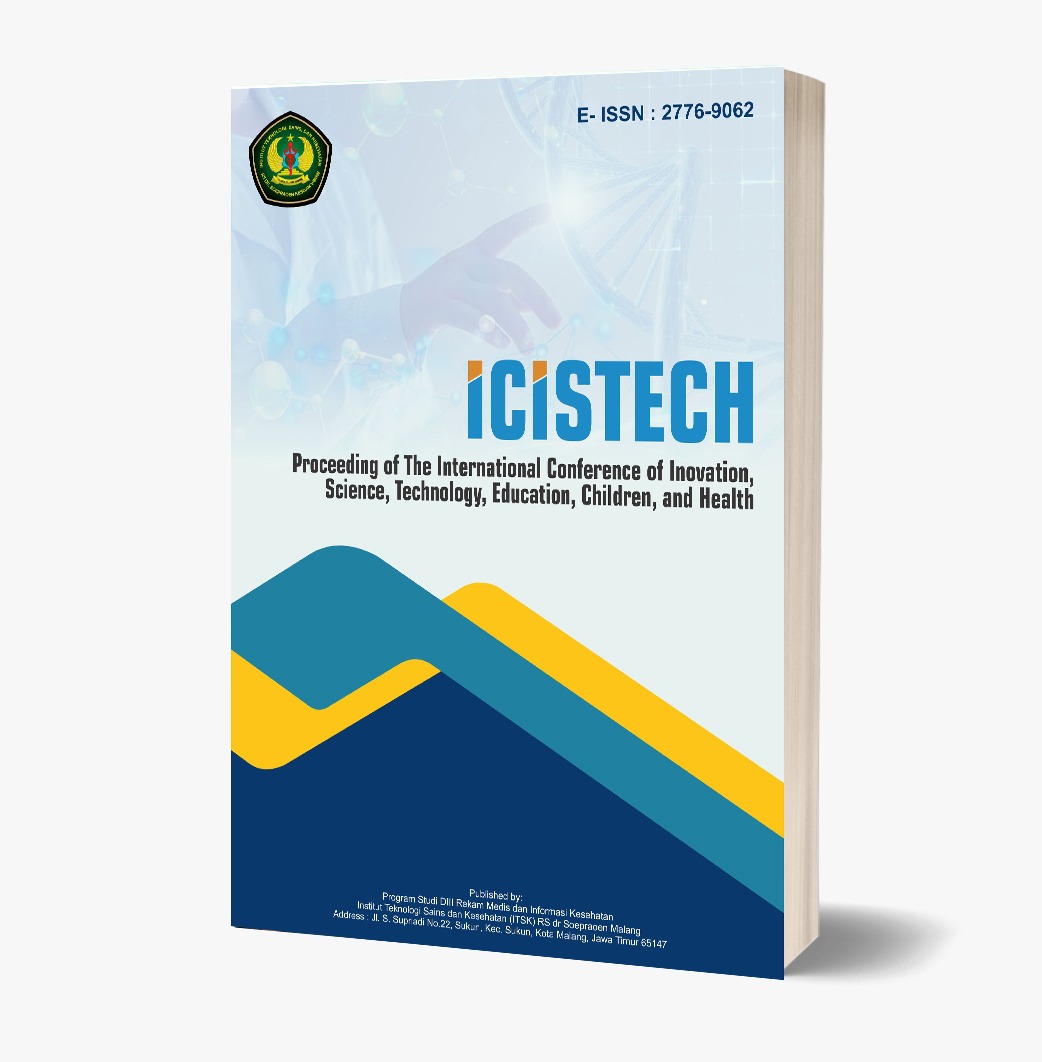Enhancing Doctor-Patient Communication through Digital Media Platforms: A Study on Innovation in Health Interaction
DOI:
https://doi.org/10.62951/icistech.v4i2.99Keywords:
Digital Media, Doctor-Patient Communication, Health Technology, Healthcare InnovationAbstract
In the digital era, communication technology enhances interaction quality across various sectors, including healthcare. Communication between doctors and patients can be improved through innovative digital media platforms. However, there is a knowledge gap regarding the effectiveness and implementation of digital media in doctor-patient interactions. This study aims to evaluate the impact of digital media platforms on doctor-patient communication and identify factors influencing the effectiveness of such communication. This research employs a qualitative method with a case study approach over six months, with inclusion criteria comprising doctors and patients actively using digital media. Subjects were selected through purposive sampling, involving 20 doctors and 50 patients. Data were analyzed using thematic analysis to identify critical patterns and themes. The findings indicate that digital media usage enhances the accessibility and responsiveness of communication, enables real-time health monitoring, and increases patient satisfaction through more personal and interactive communication. Factors such as doctors' digital skills, patients' preferences, and institutional support play significant roles in communication effectiveness. Digital media also reduce communication errors and improve the efficiency of health information delivery. The implications of this study suggest that integrating digital technology in medical communication enhances interaction quality and accelerates digital transformation in the healthcare sector.
References
Alif, I. S., Karnay, S., & Amir, A. S. (2023). Strategi komunikasi kesehatan penanganan stunting (Studi pada kelurahan Watang Bacukiki kota Parepare). Interaksi, 12(1), 66–89.
Alkhamees, M., & Alasqah, I. (2023). Patient-physician communication in intercultural settings: An integrative review. Heliyon, 9(1), e16023. https://doi.org/10.1016/j.heliyon.2023.e16023
Al-Rahmi, W. M., Al-Adwan, A. S., Al-Maatouk, Q., Othman, M. S., Alsaud, A. R., Almogren, A. S., & others. (2023). Integrating communication and task–technology fit theories: The adoption of digital media in learning. Sustainability (Switzerland), 15(10). https://doi.org/10.3390/su15108144
Alwashmi, M. F. (2020). The use of digital health in the detection and management of COVID-19. International Journal of Environmental Research and Public Health, 17(8), 2906. https://doi.org/10.3390/ijerph17082906
Boeck, M. A., Juillard, C. J., Dicker, R. A., & Joseph, B. A. (2021). Turning value into action: Healthcare workers using digital media advocacy to drive change. PLOS ONE, 16(4), e0250875. https://doi.org/10.1371/journal.pone.0250875
Boivin, A., L’Espérance, A., Gauvin, F. P., Dumez, V., Macaulay, A. C., & Lehoux, P. (2018). Patient and public engagement in research and health system decision making: A systematic review of evaluation tools. Health Expectations, 21(6), 1075–1084. https://doi.org/10.1111/hex.12804
Chandra, S., & Mohammadnezhad, M. (2021). Doctor-patient communication in primary health care: A mixed-method study in Fiji. International Journal of Environmental Research and Public Health, 18(14), 7548. https://doi.org/10.3390/ijerph18147548
Creswell, J. W., & Creswell, J. D. (2018). Research design: Qualitative, quantitative, and mixed methods approaches (5th ed.). SAGE Publications.
Denzin, N. K., & Lincoln, Y. S. (2018). The SAGE handbook of qualitative research (5th ed.). SAGE Publications.
Effendi, D. E., Handayani, S. A., Nugroho, A. P., Ardani, I., Fitrianti, Y., Karlina, K., & others. (2023). The significance of physician-patient communication on telemedicine patients’ health outcomes: Evidence from Indonesia. Health Communication, 1–10. https://doi.org/10.1080/10410236.2023.2300183
Ezeilo, C. O., Leon, N., Jajodia, A., & Han, H. R. (2023). Use of social media for health advocacy for digital communities: Descriptive study. JMIR Formative Research, 7(1), e51752. https://doi.org/10.2196/51752
Forgie, E. M., Lai, H., Cao, B., Stroulia, E., Greenshaw, A. J., & Goez, H. (2021). Social media and the transformation of the physician-patient relationship: Viewpoint. Journal of Medical Internet Research, 23(12), e25230. https://doi.org/10.2196/25230
Gordon, C. R., Rezzadeh, K. S., Li, A., Vardanian, A., Zelken, J., Shores, J. T., & others. (2015). Digital mobile technology facilitates HIPAA-sensitive perioperative messaging, improves physician-patient communication, and streamlines patient care. Patient Safety in Surgery, 9(1), 21. https://doi.org/10.1186/s13037-015-0081-7
Győrffy, Z., Boros, J., Döbrössy, B., & Girasek, E. (2023). Older adults in the digital health era: Insights on the digital health-related knowledge, habits, and attitudes of the 65-year and older population. BMC Geriatrics, 23(1), 779. https://doi.org/10.1186/s12877-023-04118-1
Huo, J., Desai, R., Hong, Y. R., Turner, K., Mainous, A. G., & Bian, J. (2019). Use of social media in health communication: Findings from the Health Information National Trends Survey 2013, 2014, and 2017. Cancer Control, 26(1), 1073274819841442. https://doi.org/10.1177/1073274819841442
Langford, A. T., Orellana, K., Buderer, N., Andreadis, K., & Williams, S. K. (2023). Role of digital health communication, sociodemographic factors, and medical conditions on perceived quality of patient-centered communication. Patient Education and Counseling. Advance online publication. https://doi.org/10.1016/j.pec.2023.09.005
Lupton, D., & Maslen, S. (2019). How women use digital technologies for health: Qualitative interview and focus group study. Journal of Medical Internet Research, 21(1), e11481. https://doi.org/10.2196/11481
Lyles, C. R., Nelson, E. C., Frampton, S., Dykes, P. C., Cemballi, A. G., & Sarkar, U. (2020). Using electronic health record portals to improve patient engagement: Research priorities and best practices. Annals of Internal Medicine, 172(11), S123–S129. https://doi.org/10.7326/M19-0877
Marino, F., Alby, F., Zucchermaglio, C., & Fatigante, M. (2023). Digital technology in medical visits: A critical review of its impact on doctor-patient communication. Frontiers in Psychiatry, 14, 1226225. https://doi.org/10.3389/fpsyt.2023.1226225
Marino, F., Alby, F., Zucchermaglio, C., & Fatigante, M. (2023). Digital technology in medical visits: A critical review of its impact on doctor-patient communication. Frontiers in Psychiatry, 14, 1226225. https://doi.org/10.3389/fpsyt.2023.1226225
Muscat, D. M., Shepherd, H. L., Nutbeam, D., Trevena, L., & McCaffery, K. J. (2021). Health literacy and shared decision-making: Exploring the relationship to enable meaningful patient engagement in healthcare. Journal of General Internal Medicine, 36(2), 521–524. https://doi.org/10.1007/s11606-020-06495-5
Schick, T. S., Höllerl, L., Biedermann, T., Zink, A. M., & Ziehfreund, S. (2022). Impact of digital media on the patient journey and patient-physician relationship among dermatologists and adult patients with skin diseases: Qualitative interview study. Journal of Medical Internet Research, 25, e44129. https://doi.org/10.2196/44129
Scott, B. K., Miller, G. T., Fonda, S. J., Yeaw, R. E., Gaudaen, J. C., Pavliscsak, H. H., & others. (2020). Advanced digital health technologies for COVID-19 and future emergencies. Telemedicine and e-Health, 26(10), 1226–1233. https://doi.org/10.1089/tmj.2020.0140
Sharma, A. E., Rivadeneira, N. A., Barr-Walker, J., Stern, R. J., Johnson, A. K., & Sarkar, U. (2018). Patient engagement in health care safety: An overview of mixed-quality evidence. Health Affairs, 37(11), 1813–1820. https://doi.org/10.1377/hlthaff.2018.0708
Smailhodzic, E., Hooijsma, W., Boonstra, A., & Langley, D. J. (2016). Social media use in healthcare: A systematic review of effects on patients and on their relationship with healthcare professionals. BMC Health Services Research, 16(1), 442. https://doi.org/10.1186/s12913-016-1691-0
Stern, E., Breton, Z., Alexaline, M., Geoffroy, P., & Bungener, C. (2024). Redefining the relationship in digital care: A qualitative study of the Digital Therapeutic Alliance. Encephale-Revue De Psychiatrie Clinique Biologique Et Therapeutique, 50(1), 58–65. https://doi.org/10.1016/j.encep.2023.08.002
Sultan, M. I., & Amir, A. S. (2023). The utilization of digital media in health communication in Indonesia. Journal of Health Communication, 14(2), 23–34.
Torous, J., Wisniewski, H., Bird, B., Carpenter, E., David, G., Elejalde, E., & others. (2019). Creating a digital health smartphone app and digital phenotyping platform for mental health and diverse healthcare needs: An interdisciplinary and collaborative approach. Journal of Technology in Behavioral Science, 4(2), 73–85. https://doi.org/10.1007/s41347-019-00095-w
Vega-Hurtado, C. (2020). [Importance of doctor-patient communication strategies]. Revista Médica del Instituto Mexicano del Seguro Social, 58(2), 197–201.
Willemsen, R. F., Aardoom, J. J., van der Galiën, O. P., van de Vijver, S., Chavannes, N. H., & Versluis, A. (2023). A digital platform to support communication and organization in the general practice: Evaluation of healthcare usage and costs using claims data of a health insurer. International Journal of Medical Informatics, 181, 105296. https://doi.org/10.1016/j.ijmedinf.2023.105296
Wisniewski, H., & Torous, J. (2020). Digital navigators to implement smartphone and digital tools in care. Acta Psychiatrica Scandinavica, 141(4), 350–355. https://doi.org/10.1111/acps.13150
Wu, Y. Q., & Gong, J. (2023). Mobile social media as a vehicle of health communication: A multimodal discourse analysis of WeChat official account posts during the COVID-19 crisis. Humanities and Social Sciences Communications, 10(1), 246. https://doi.org/10.1057/s41599-023-01722-1
Downloads
Published
How to Cite
Issue
Section
License
Copyright (c) 2024 Proceeding of The International Conference of Inovation, Science, Technology, Education, Children, and Health

This work is licensed under a Creative Commons Attribution-ShareAlike 4.0 International License.













